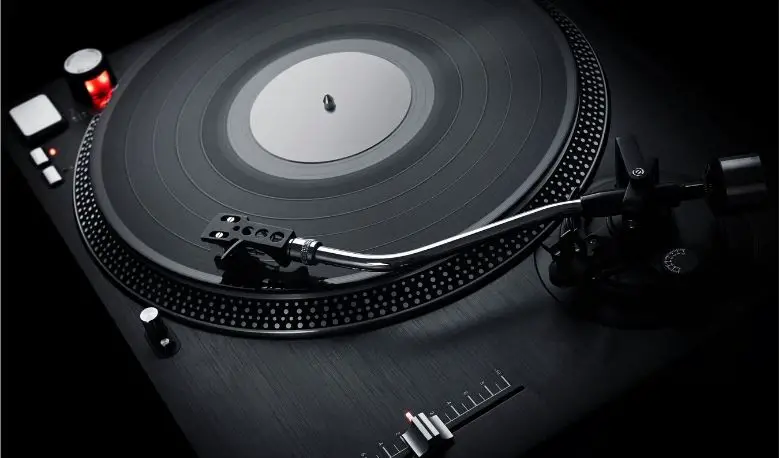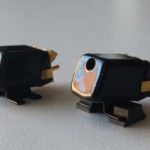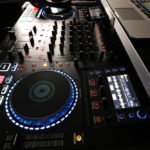The reason why turntables are so expensive is that manufacturers make them using parts that cannot be easily mass-produced. Also, because these parts need to be able to interact with each other properly, the manufacturing of the turntables themselves is not cheap either.
Turntable Prices
Because turntables are such intricate pieces of equipment made with very specific parts, they can be costly to produce and even more costly to buy. This is especially true if you are looking for a high end turntable.
With the different components and moving parts within a turntable, it makes sense why they can cost so much.
This article will take a closer look at why turntables are so expensive and some recommendations for those looking to invest in one.

Turntable Components
The components that make up a turntable have different but equally essential functions. If these components cannot correctly interact with each other, your turntable will not play records correctly.
The main components of a turntable are:
Tonearm
A tonearm is the adjustable radial arm that attaches to the base of your turntable. You move the tonearm to place the needle onto a vinyl.
The tonearm holds the turntable’s cartridge and has a counterweight that helps balance the cartridge for optimal tracking performance. You’ll find tonearms can be either curved or straight.
Cartridge
The cartridge is the turntable part that connects to the tonearm and houses the stylus needle.
Cartridges convert vibrations from records into electrical signals sent to speakers or headphones. Many audiophiles consider the cartridge one of the most crucial parts of a turntable’s sound quality.
There are several different types of turntable cartridges, but they all do the same thing.
Stylus
A stylus is a needle that actually makes contact with your vinyl record. The stylus rides in the record’s grooves and converts the record’s movements into an audio signal.
A turntables stylus is a vital turntable component.
If there is anything wrong with it or how it fits in your cartridge. In that case, you may have issues with sound quality or it could even damage your records.
Bearing
The bearing is an important turntable component because it enables the platter to be level and rotate consistently. If the bearing is not manufactured correctly, this will affect your turntable’s performance.
Motor
The motor is the part of a turntable that spins the platter. The motor is often considered the heart of your turntable.
Your turntable motor must have a consistent speed; otherwise, your turntable will have issues playing records at the correct tempo.
Turntable motors are powered by either AC (Alternating Current) or DC (Direct Current). AC and DC motors perform the same task. They just do it in different ways.
Platter
The platter is the circular plate where you place your record and is usually made from aluminum but can be made of other materials like acrylic or even glass.
The purpose of the platter is to hold your record in place while your turntable spins it.
Pitch Control Slider
The next turntable component that you should be familiar with is the pitch control slider.
The pitch control slider is located on the base of your turntable. Almost all DJ turntables will have a pitch control slider, and you can use this mechanism to change the speed your turntable plays a vinyl record.
Although the RPM (Revolutions Per Minute) settings of 33, 45, and 78 also control the speed at which your turntable spins a record, the pitch control slider allows you to pick a speed that falls in between these three standard settings.
DJs can use this function to speed up or slow down music which allows them to match the tempos of two different songs or create other cool effects.
The pitch control slider is an essential aspect of a DJs turntable.
Slipmat
The final component you should be aware of is the slipmat. This is a slippery piece of a cloth-like material that sits on top of your platter. The slick surface allows records to spin on your turntable freely in any direction instead of your platter holding it in place.
The slipmat is a necessary component for DJs looking to scratch records.
Keep in mind; the slipmat is a component that does not usually come standard with most turntables. Instead, it is something that you must buy for your turntable.
Audiophile Turntables
An audiophile is a person who is very enthusiastic about good sound quality. Therefore, an audiophile turntable is designed with sound quality and performance in mind.
An audiophile turntable is by no means a budget turntable, and it will cost you more than other units. These are expensive turntables! The reason for this is because they contain higher quality components such as:
- The tonearm
- The cartridge
- The stylus
- The motor
- The bearing
- The body of the turntable itself
Not only this, but there is much more care and precision that goes into the manufacturing of an audiophile turntable, so this will cost significantly more also.
One thing to note is that audiophile turntables typically omit specific components such as preamp, pitch control slider, and USB connectivity.
This is because audiophile turntables are geared towards sound quality for listening to music and not DJing. Audiophiles do not need these features.
Audiophile turntables are perfect for someone looking to optimize sound quality in their home vinyl record listening setup, but they are not ideal for DJing because they lack certain features.
Analog Turntables
An analog turntable is a turntable that does not have any digital components such as USB connectivity. USB connectivity in a turntable allows you to convert vinyl records into digital formats. Hence, if this is something that you are looking to get out of your turntable, it is probably best for you to steer clear of an analog turntable.
Analog turntables are typically not preferred for DJs because they have no pitch control or speed functions other than the standard 33, 45, and sometimes 78 RPM speeds.
Many people argue that analog turntables offer a warmer and more classic sound for listening to vinyl records. Also, analog turntables do not have certain features, making them more user-friendly and straightforward.
While some users prefer the sound of an analog turntable, they are not the ideal choice for DJs.
Belt Drive vs. Direct Drive
When looking at a turntable, something essential to consider is whether it is belt drive or direct drive.
The drive type in a turntable refers to how your motor spins your platter.
Belt Drive
In a belt drive system, the motor will be somewhere to the side of the platter on the base of the record player.
A belt connects the motor to the platter, and as the motor spins, it also causes the platter to spin.
Two main drawbacks of belt drive turntables are that they take a few seconds to reach full speed and that the belt can wear out.
This is one more component you will have to worry about maintaining.
Direct Drive
In a direct drive system, the motor is located right under the platter in the center of the record player. There is no belt required because the motor attaches directly to the platter.
Direct drive systems reach full turning speed almost instantly.
A direct-drive turntable also allows your record player’s platter to spin freely instead of a belt holding it in place.
For this reason, direct-drive turntables are the obvious choice for DJs looking to beatmatch or scratch records.
When I first began DJing, it was on a set of belt-driven Soundlab turntables. It wasn’t easy, but if you learned to beatmatch on those, you could do it on anything!
The Need For Precision
Another key factor when considering the cost of turntables is that they must operate so precisely to function and track records.
A record player reads small details in a groove about as wide as a human hair and then sends that signal to play through headphones or speakers.
For your turntable to do this, not only do the individual parts need to be correctly produced, but it is also imperative that the manufacturer assembles them correctly.
Because this is such an exact process with no room for error, the manufacturing of turntables is slower and much more expensive than other types of electronics.
What Turntable Should I Get?
Hopefully, by now, you see why the cost of turntables can be so high.
If this is the case and now you are thinking about buying one, I want to provide you with some recommendations.
Because we are looking at turntables geared towards DJing, all these recommendations will be for direct-drive turntables and not belt-driven units.
My first recommendation for a DJ looking to score an incredible turntable is the Technics SL-1200MK7. The SL-1200 turntable series has been manufactured and trusted by DJs worldwide since 1972.
Although there are some complaints that SL-1200 turntables are not produced to the same standards as they once were, the Technics SL-1200MK7 turntable is still an excellent choice for a DJ looking to buy a high-end turntable.
My next recommendation is from Gemini Sound and is available for a somewhat affordable price compared to other turntables.
It is not as high quality as other turntables. Still, for the most part, this turntable satisfies user needs.
If you are looking for an entry-level turntable, the Gemini Sound TT-4000 is definitely an option to consider.
Another solid choice is the Audio Technica AT-LP120BK.
Not only is Audio-Technica a reliable maker, but this turntable has excellent reviews also.
A few users complained that it is a bit too noisy when playing certain records. Still, other than that, most people have nothing but good things to say about this turntable.
The AT LP120BK is a fantastic choice for someone looking to buy a high-quality turntable without breaking the bank.
The next option that I want to show you is from Pioneer.
Pioneer is a reputable manufacturer, and this turntable is very highly rated.
It’s worth bearing in mind that their customer service can be challenging to deal with if you have any issues, and transporting the turntable can bend and warp the tonearm.
The Pioneer DJ PLX-1000 is an incredible DJ turntable for anyone looking for a high-performance unit for their setup.
Related Questions
Why do turntables seem so expensive compared to other audio players?
Turntables seem more expensive than other audio players because they use complex mechanical parts with specific standards.
A CD player or Bluetooth speaker is much cheaper because they use only digital components, and the assembly process is more straightforward.
Will a cheap turntable damage your vinyl records?
Yes, specific cheap turntables will damage your vinyl records.
This is because they often lack a counterweight on the tonearm. The counterweight makes it so that the total weight of the tonearm will not be resting on your vinyl records.
Without a counterweight, the full weight of the tonearm will bear down on the stylus as it tracks your records. This can cause damage to your vinyl records!
Why have record players grown in popularity?
The main reason why record players have grown in popularity is due to the boom in vinyl record sales in recent years.
With sales of vinyl records on the rise, more and more people are looking for devices to listen to them on.
Do you prefer a direct drive or belt driven turntable?
I prefer to use a direct drive turntable. The reason for this is simple; a belt-driven turntable can not turn freely because the belt holds your platter in place. This means it starts and stops much quicker, which is essential for beatmatching and scratching. This makes it the obvious choice for DJs.
Why would anyone want to build a vinyl record collection?
Personally, vinyl is my favorite type of music, media, and probably why I have a collection of over 2000 records.
There is nothing quite like putting the stylus down on a piece of vinyl for a truly authentic listening experience. Also, it’s nice to have a physical product in your hands in such a digital age.
From a DJs point of view, it’s the most hands-on form of DJing.
Final Words
As I have shown you in this article, turntables are as expensive because of how much goes into making them.
They are intricate devices that rely on many different components working together to function correctly.
Not only are these components difficult to produce on a mass scale, but they must be assembled to such precise specifications, making the manufacturing process time-consuming.
Although a high-quality turntable will cost a good amount of money, it is well worth the investment if you are a vinyl or DVS DJ looking to hone your craft.
Click here for all our turntable guides.
We hope you love the products we recommend. We may collect a commission if you purchase through one of our links. This doesn't cost you anything extra. If you do, thank you! As an Amazon Associate, I earn from qualifying purchases.










